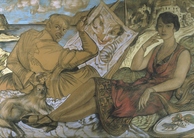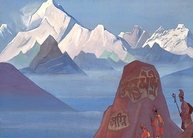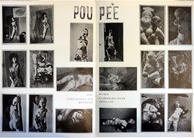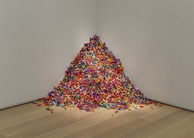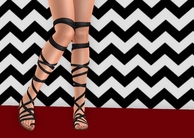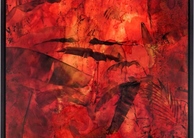Passing Time in The Garden of Earthly Delights by Hieronymus Bosch
By
2014, Vol. 6 No. 03 | pg. 1/3 | »
KEYWORDS:
In one of his most famous triptychs, the Garden of Earthly Delights, Hieronymus Bosch uses a linear and chronological order to represent a gradual fall of man into sin. In a world where ‘bad’ has existed in small amounts since the creation of the world, man grows to indulge in earthly delights and physical pleasures, which over time leads to his eternal suffering and the loss of control over that which he once ruled. While many other great triptychs of the fifteenth century utilize the three separate panels and the outside image as just that – three or four separate images united thinly by a theme – Bosch presents the images in a linear narrative to tell his story. For a great length of time, triptychs were used as a way for artists to represent biblical and religious scenes and stories that would most likely be placed near or over an altar. In 1480, Netherlandish artist Hieronymus Bosch began working on a very different type of triptych. The Garden of Earthly Delights uses the form of the triptych to illustrate a more secular and narrative story of sin and judgment. Rather than showing a scene of monks and nuns, or of an Annunciation or Deposition, Bosch focuses on figures with no holy or saintly distinctions. Done in oil on panel and finished around 1490, Bosch’s work was intended for the audience of the court of Philip II (and the work was ultimately appreciated by the audience there). The king’s spiritual counselor considered the work to be powerful, deep, and worthy of study (Beagle 20). It was an innovation of the triptych form, both in its subject matter and its presentation. Bosch’s Garden of Earthly Delights consists of four images. When the panels are all closed, the front of the triptych shows the viewer Bosch’s Creation, a gray-tone image in which God sits at the top left corner, watching over the world encased in a glass globe on the third day of creation, just as plants are beginning to come to life. Once opened, there are three additional images. The very left panel, Paradise, shows the sixth day, when God created man and woman. Specifically, in this scene, he is presenting Eve to Adam, as animals run around in the rest of Paradise. The central panel is Imaginary Paradise, in which a plethora of nude figures ride animals, eat fruits, and run around in general carefree celebration and acts of passion. The right panel, Hell, shows figures being eternally punished in all sorts of ways by animals and strange hybrid creatures, with a city just visible in the background through the dark of the night.In their discussion of the Garden of Earthly Delights, many scholars focus on the plethora of symbols in the central Imaginary Paradise panel, but often neglect to consider it in relation to the other three images that make up the triptych. Some scholars argue that, like the tendency of many triptychs before Bosch, these four images do not necessarily read in a particular chronological order, or follow a clear narrative, but rather just show four separate images that have a common theme uniting them. Hans Belting insists that the piece cannot be read chronologically because, since Eve is not depicted eating the forbidden apple in Eden, any continuity between Paradise and Imaginary Paradise do not follow the biblical stories of the Fall of Man (86). Because the Fall is not depicted, some scholars argue that the images cannot be read to follow the biblical story. But just because a different part of the story is depicted, in this case the union of Adam and Eve rather than the moment when Eve eats the apple, it does not mean that the triptych is not a chronological narrative. For example, Lynne Jacobs discusses the possibility of a chronological reading that shows the ‘unfolding of world history’ due to divisions within each scene that could imply a passing of time (1038-40). Alternatively, as this paper proposes, the triptych reads the panels in a linear narrative, beginning at the outside and then from left to right, rather than as a passing of time from one panel to the next. Read this way, the images on the inside can still be read in an order that depicts the beginning of man, the sinning of man, and the punishment of man in a logical narrative sequence. Just because Bosch’s omitted a crucial moment (Eve eating the forbidden fruit) does not mean that the chronological flow of the triptych is hindered. In fact, Bosch avoided the most traditional features of the story in his creation of the Garden of Earthly Delights. At the time Bosch was working, there were three typical features of a Netherlandish triptych: the first of these features was a devotion to religious subject matter (Jacobs 1009). Most triptychs were meant to be displayed as altarpieces, and therefore often included religious and biblical scenes, appropriate for being viewed and contemplated in a church, as they would provoke religious and devotional thought in a place of worship. Another common feature of most Netherlandish triptychs of Bosch’s time was the sense of a hierarchy between the images. Most triptychs emphasized the importance of the inner panels, placing less significance on the outer image. Once the triptych was opened, the central image was meant to be the most prominent, and the wings were inteded to be read secondarily and after the central panel had been read (1010). Shirley Blum expands upon this view held by Early Netherlandish artists when working with triptychs. They executed their works following the idea that the viewer contemplates the exterior first, since it is “less complex than the interior because it is smaller in size and simpler in iconography… The spectator must move through the central panel and then through the two wings” (4). In this way, everything compliments the center image. In her book “Early Netherlandish Triptychs” Blum discusses some of the more well-known artists and their triptychs, each which followed this formula. For example, Rogier Van der Weyden, in his work on the Bladelin Triptych, emphasizes the nativity scene in the central panel. All the figures in the wings look towards to center panel, where the most important event is occurring. Dieric Bouts’ Altarpiece of the Blessed Sacrament works in a similar manner, the central image being the focus and namesake of the work. Rather than being read in a linear manner, it was as if opening the altarpiece would show the viewer the heart of the triptych, and all that was read before and after were supporting images to the center panel. Bosch’s triptychs do not tend to follow this manner of reading and hierarchy. Thirdly and lastly, triptychs of Bosch’s contemporaries were conceived additively, meaning that, once the piece was opened, it was seen as having three separate images (the central one being the most important), that all came together to form a whole (1010). This additive idea, three panels uniting to form one triptych, runs contrary to what more modern viewers might expect of an image, that all three panels could be meant to be one image from the beginning, rather than three that come together in some sense. This aspect of Netherlandish triptychs adds further to the feature of the hierarchical way of viewing, because, while the inside images unite to form a whole, the outer image is still made secondary, seen as only a prelude to the main event inside. While these three features- religious subject matter, a sense of hierarchy, and the concept of additive images- were traditional to the reading of most Netherlandish triptychs of the fourteen- and fifteen-hundreds, Hieronymus Bosch’s approach to his triptychs was much more innovative. The first major difference between many of Bosch’s works and those of his contemporaries was the difference in subject matter. While other artists focused on strictly and blatantly religious iconography, Bosch’s work contained much more secular settings to portray themes of virtues and vices. His works, though they often contain some sort of religious or biblical content, “emphasize moral, or more often immoral, behavior in the earthly realm instead of salvation in the afterlife...[they] are secular in the most basic sense of the term because their focus is worldly, not spiritual” (Jacobs 1012-13). For example, the Garden of Earthly Delights, while it does contain biblical images of God and the Creation story, has a much stronger focus on the pursuit and punishment of earthly indulgences and carnal pleasure than God’s role in judging man, or how to reach salvation after committing these sins. The second major difference between features of Bosch’s triptychs and those of his contemporaries is that, while many other triptychs had the hierarchical order to their images, Bosch broke this hierarchy down. He chose to make the exteriors of his triptychs as important to the overall piece as the interior panels. He achieved this stronger impact on the exterior by use of colors, design, and overall “greater visual and thematic impact” (Jacobs 1012). In the Garden of Earthly Delights, he achieved this breakdown of the hierarchical system by the use of the roundel shape and warm, grisaille color scheme. According to Jacobs, the circular shape of the globe on the front of the triptych creates a strong visual impact, providing the viewer with a “clearer, bolder design compared to the interiors” which allows it to be as visually compelling as the vibrant and busy scene found inside (1029). And despite Bosch’s use of grays in the Creation image, he still includes warm tones, such as a pale pink and creamy, rather than flat, white, in order to add a more lively tone to what would otherwise appear as a stone cold and lifeless kind of grey (1025). These innovations make the outside scene of the triptych more compelling to the viewer, and therefore more significant to the viewing experience and the narrative of the piece. The third element of Netherlandish triptychs, the additive feature, is also innovated in Bosch’s works. Rather than seeing his work as three inner panels coming together, Bosch approached his triptychs by stressing the unity of the whole between all the panels (1012). His works seem to stress unity between the whole of all three images, plus the exteriors. In the Garden of Earthly Delights, all three inner panels are visually stimulating, and provide plenty for the viewer to discover upon repeated observations. Building from Jacob’s observations on this sense of unity, one can conclude that this work is designed with a chronological narrative. Since Bosch’s work includes a smooth unity of images, one can see that the exterior Creation image provides the beginning of the story, connecting itself with the inside panels to form one work, rather than four separate images that unite after the central panel has been viewed. In Bosch’s work, contrary to that of his contemporaries, one panel cannot reign prominent and more significant than any of the other panels- they must be viewed together in order for the triptych to reach its true intention to convey a chronological story in an understandable order. Bosch seems to be stating through this piece that the world has in it inherent evil, and that without rational thought and moderation over their actions and indulgences, humans will ruin themselves by giving into its temptations. With this general understanding of how Bosch approached the design of his triptychs, one can look more specifically at the Garden of Earthly Delights, using these features of his work to gain a better understanding of the message behind this vibrant and captivating piece. As was stated earlier, this work seems to lay out a narrative that follows through the four images, starting at the Creation on the exterior, and working its way from left to right on the inner panels, going through the creation and union of man and woman, through the many ways in which man gives in to his desires, and finally, in Hell, when these desires dominate and punish him for being so unruly. Bosch seems to be stating through this piece that the world has in it inherent evil, and that without rational thought and moderation over their actions and indulgences, humans will ruin themselves by giving into its temptations. He represents this by showing the fall of man as a whole, not simply just through Eve, so that the viewer sees that every man and woman is capable of their own demise, with or without the assistance of Eve’s Original Sin. Hence her consumption of the apple is not portrayed in this triptych, as if every human begins life with a slate clean of any sins. The variety of earthly temptations in the Garden of Earthly Delights is seemingly limitless. Both by looking at the symbolism in the triptych, and by looking at Bosch’s works as a whole, one can understand that this is the main message of the work. As many scholars have noted, Bosch often uses secular images to comment on humanity’s tendencies to abandon itself to indulgence and, through over-indulgence, sin. As P.S. Beagle writes on Bosch’s dealings with man and temptations, “This is among the most recurrent of Bosch’s themes: one’s humanity- or one’s soul- is dreadfully easy to lose, and what we abandon ourselves to possess, we become” (90). This is literally the case in the Garden of Earthly Delights. In the Hell panel, those things that men and women pursued and indulged themselves in the Imaginary Paradise panel become the things that dominate and punish them for eternity. While P.S. Beagle notes how abandonment of temptation is a general theme of Bosch’s, specifically in the Garden of Earthly Delights the figures give themselves over to the most earthly of temptations. They frolic with animals and pursue oversized fruits. All of the panels show the power of earthly things and the existence of the unruly side of nature, and throughout the narrative, the figures lose themselves completely in this necessary evil, present since God manifests it in the Creation panel. As Peter Glum quotes Tolnay saying about this triptych, “the artist’s purpose is above all to show the evil consequences of sensual pleasure and to stress its ephemeral character…the paradise contains the germ of its own destruction” (45). There is at least a hint of evil to be found in each scene of the triptych, and through the narrative the viewer follows its growth and the figures’ increasing willingness to give in to it. Without moderation and rationale, they encourage the evil in the world, and this ‘germ’ of Paradise leads to their demise and their eternal punishment. There are two ways to track the chronological development of the narrative in the Garden of Earthly Delights. The evolution of this evil and man’s indulgence in sin from one panel to the next is one way to do so. But before breaking this evolution down panel by panel, the other way of tracking this must be explained, for it is much simpler, and helps to unite the inner three panels visually. All three inner landscapes echo one another quite closely, almost as if they were the same territory. Some scholars hold that the Garden shown in Paradise and the Imaginary Paradise are one in the same Garden, which becomes Hell on earth on the Hell panel (Beagle 45). The way in which the natural settings flow into each other from panel to panel is quite striking. In the Paradise panel, the very back of the scene has blue, almost rocky-looking forms, that seem to dip down into the Imaginary Paradise to continue as rocky forms further off into the distance, almost seeming like a mountain range off on the edge of Paradise. These background forms become symmetrical and mirror the Paradise forms when they enter back into the Hell panel as a dark combination of what looks like rocky (again, possibly mountainous) forms and some sort of buildings or structures as the beginning of a civilization of man. Closer to the center level of the landscapes, each panel has manmade-looking structures and bodies of water that act in the same way, creating a sense of symmetry while smoothly transitioning the landscape from one scene to the next. In Paradise, there is one pink structure, with an owl inside of it, found in the middle of a small body of water. Transitioning into the Imaginary Paradise, the water seems to follow the curve from the Paradise river, leading slightly up closer to the top of the panel. In this center panel, there are three larger structures and two smaller ones, all either pink or blue in color, and with figures climbing and performing stunning balance and acrobatic moves along their rims. These structures sit in and along the edges of this body of water flows from the left panel into this central image. In the Hell panel on the right, this body of water moves down slightly once again, mirroring the water in the Paradise panel. In this body of water is the striking structure of the Tree Man, who houses inhabitants of his own, what seem to be a group of gluttons being served by a hellish bartender. Just like the mountainous structures in the extreme background of the three panels, these structures and bodies of water in the middle ground create this same unified type of landscape. In sum, the scenes take place in about the same location, at different points in time.Continued on Next Page » Suggested Reading from Inquiries Journal
Inquiries Journal provides undergraduate and graduate students around the world a platform for the wide dissemination of academic work over a range of core disciplines. Representing the work of students from hundreds of institutions around the globe, Inquiries Journal's large database of academic articles is completely free. Learn more | Blog | Submit Latest in Visual Arts |












